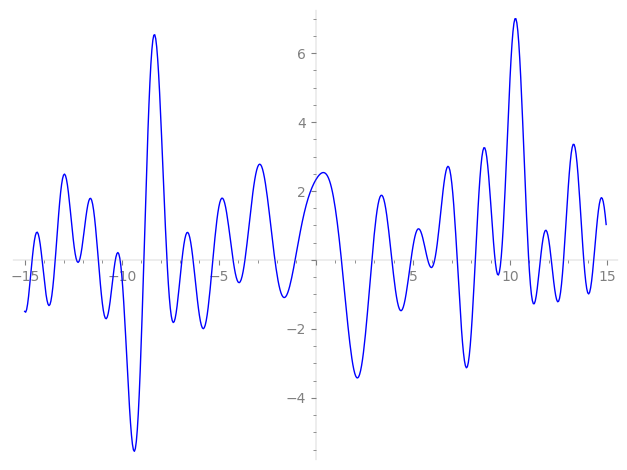| L(s) = 1 | + (0.866 − 0.5i)2-s + (−0.866 − 0.5i)3-s + (0.499 − 0.866i)4-s + (0.469 + 0.812i)5-s − 0.999·6-s + (0.642 − 2.56i)7-s − 0.999i·8-s + (0.499 + 0.866i)9-s + (0.812 + 0.469i)10-s + (4.56 + 2.63i)11-s + (−0.866 + 0.499i)12-s − 0.413·13-s + (−0.727 − 2.54i)14-s − 0.938i·15-s + (−0.5 − 0.866i)16-s + (4.70 + 2.71i)17-s + ⋯ |
| L(s) = 1 | + (0.612 − 0.353i)2-s + (−0.499 − 0.288i)3-s + (0.249 − 0.433i)4-s + (0.209 + 0.363i)5-s − 0.408·6-s + (0.242 − 0.970i)7-s − 0.353i·8-s + (0.166 + 0.288i)9-s + (0.256 + 0.148i)10-s + (1.37 + 0.793i)11-s + (−0.249 + 0.144i)12-s − 0.114·13-s + (−0.194 − 0.679i)14-s − 0.242i·15-s + (−0.125 − 0.216i)16-s + (1.14 + 0.659i)17-s + ⋯ |
\[\begin{aligned}\Lambda(s)=\mathstrut & 1218 ^{s/2} \, \Gamma_{\C}(s) \, L(s)\cr =\mathstrut & (0.499 + 0.866i)\, \overline{\Lambda}(2-s) \end{aligned}\]
\[\begin{aligned}\Lambda(s)=\mathstrut & 1218 ^{s/2} \, \Gamma_{\C}(s+1/2) \, L(s)\cr =\mathstrut & (0.499 + 0.866i)\, \overline{\Lambda}(1-s) \end{aligned}\]
Particular Values
| \(L(1)\) |
\(\approx\) |
\(2.329598766\) |
| \(L(\frac12)\) |
\(\approx\) |
\(2.329598766\) |
| \(L(\frac{3}{2})\) |
|
not available |
| \(L(1)\) |
|
not available |
\(L(s) = \displaystyle \prod_{p} F_p(p^{-s})^{-1} \)
| $p$ | $F_p(T)$ |
|---|
| bad | 2 | \( 1 + (-0.866 + 0.5i)T \) |
| 3 | \( 1 + (0.866 + 0.5i)T \) |
| 7 | \( 1 + (-0.642 + 2.56i)T \) |
| 29 | \( 1 + (5.13 - 1.63i)T \) |
| good | 5 | \( 1 + (-0.469 - 0.812i)T + (-2.5 + 4.33i)T^{2} \) |
| 11 | \( 1 + (-4.56 - 2.63i)T + (5.5 + 9.52i)T^{2} \) |
| 13 | \( 1 + 0.413T + 13T^{2} \) |
| 17 | \( 1 + (-4.70 - 2.71i)T + (8.5 + 14.7i)T^{2} \) |
| 19 | \( 1 + (0.887 - 0.512i)T + (9.5 - 16.4i)T^{2} \) |
| 23 | \( 1 + (1.53 + 2.66i)T + (-11.5 + 19.9i)T^{2} \) |
| 31 | \( 1 + (-3.69 - 2.13i)T + (15.5 + 26.8i)T^{2} \) |
| 37 | \( 1 + (-0.681 + 0.393i)T + (18.5 - 32.0i)T^{2} \) |
| 41 | \( 1 - 2.13iT - 41T^{2} \) |
| 43 | \( 1 + 10.1iT - 43T^{2} \) |
| 47 | \( 1 + (-9.82 + 5.67i)T + (23.5 - 40.7i)T^{2} \) |
| 53 | \( 1 + (-5.71 + 9.90i)T + (-26.5 - 45.8i)T^{2} \) |
| 59 | \( 1 + (3.28 - 5.69i)T + (-29.5 - 51.0i)T^{2} \) |
| 61 | \( 1 + (7.80 - 4.50i)T + (30.5 - 52.8i)T^{2} \) |
| 67 | \( 1 + (-1.18 + 2.05i)T + (-33.5 - 58.0i)T^{2} \) |
| 71 | \( 1 - 8.65T + 71T^{2} \) |
| 73 | \( 1 + (1.72 + 0.995i)T + (36.5 + 63.2i)T^{2} \) |
| 79 | \( 1 + (-3.95 + 2.28i)T + (39.5 - 68.4i)T^{2} \) |
| 83 | \( 1 + 5.27T + 83T^{2} \) |
| 89 | \( 1 + (-0.790 + 0.456i)T + (44.5 - 77.0i)T^{2} \) |
| 97 | \( 1 - 18.1iT - 97T^{2} \) |
| show more | |
| show less | |
\(L(s) = \displaystyle\prod_p \ \prod_{j=1}^{2} (1 - \alpha_{j,p}\, p^{-s})^{-1}\)
Imaginary part of the first few zeros on the critical line
−10.08552342366292711901229605025, −8.861493790742628412306534629143, −7.67088073452040180367814100284, −6.90026457840930320390959631258, −6.32621097645455565205624162301, −5.30850553559276858677425621646, −4.26610513846274451581735866005, −3.65545388531876812830058871032, −2.11184108218332376915628405066, −1.07110618291493118191439016694,
1.31442136184064871473014637229, 2.88312875729919443644238228674, 3.91375096926804314221446525809, 4.89492594421677451549804511512, 5.76183109877555474386726093252, 6.11743305001463973115646920236, 7.28097298081686347391580461217, 8.210777553018041453472579506365, 9.230082739192955305860071702318, 9.532446580776889010738453028856

